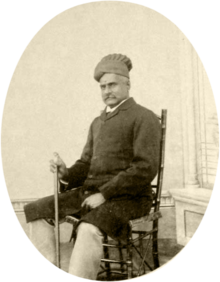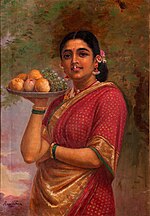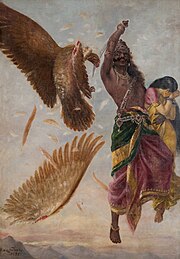Raja Ravi Varma
From Wikipedia, the free encyclopedia
| Raja Ravi Varma | |
|---|---|
 | |
| Born | April 29, 1848[1] Kilimanoor, Trivandrum,Travancore |
| Died | October 2, 1906 (aged 58) Kilimanoor, Trivandrum, Travancore, British Raj |
| Occupation | Painter |
| Signature |  |
Raja Ravi Varma (Malayalam: രാജാ രവി വര്മ്മ) (April 29, 1848 – October 2, 1906) was an Indian artist from the princely state of Travancore(presently in Kerala) who achieved recognition for his depiction of scenes from the epics of the Mahabharata and Ramayana. His paintings are considered to be among the best examples of the fusion of Indian traditions with the techniques of European academic art.
Varma is most remembered for his paintings of sari-clad women portrayed as shapely and graceful. Varma's paintings became an important motif of the time, reproductions being found in almost every middle-class home.[2] His exposure in the west came when he won the first prize in the Vienna Art Exhibition in 1873. Raja Ravi Varma died in 1906 at the age of 58. He is considered among the greatest painters in the history of Indian art.
Early life [edit]
Raja Ravi Varma was born as Ravi Varma Koil Thampuran of Kilimanoor palace, in the erstwhile princely state of Travancore (Thiruvithankur) in Kerala. His father Ezhumavail Neelakanthan Bhattatiripad was an accomplished scholar, and his mother Umayamba Thampuratti (died 1886) was a poet and writer whose work Parvati Swayamvaram was published by Raja Ravi Varma after her death. His siblings were C. Goda Varma (born 1854), C. Raja Raja Varma (born 1860) and Mangala Bayi Thampuratti, who was also a painter.
At a young age he secured the patronage of HH Maharajah Ayilyam Thirunal of Travancore (a relative) and began formal training thereafter.[3] He was trained in water painting by Rama Swami Naidu and later in oil painting by Dutch portraitist Theodor Jenson.
Raja Ravi Varma High School at Kilimanoor was named after him. There are many cultural organizations throughout Kerala in his name. His palace is nearly 6 kilometers from Ponganadu, 7.7 kilometers from Pazhayachanda and 36 km from Trivandrum, the capital of Kerala.
Art career [edit]
Raja Ravi Varma received widespread acclaim after he won an award for an exhibition of his paintings at Vienna in 1873. Raja Ravi Varma's paintings were also sent to the World's Columbian Exposition held in Chicago in 1893 and he was awarded two gold medals.[4] He travelled throughout India in search of subjects. He often modeled Hindu Goddesses on South Indian women, whom he considered beautiful. Ravi Varma is particularly noted for his paintings depicting episodes from the story of Dushyanta andShakuntala, and Nala and Damayanti, from the Mahabharata. Ravi Varma's representation of mythological characters has become a part of the Indian imagination of the epics. He is often criticized for being too showy and sentimental in his style. However his work remains very popular in India. His many fabulous paintings are available at Laxmi Vilas Palace of Vadodara.
Honours [edit]
In 1904, Viceroy Lord Curzon, on behalf of the King Emperor, bestowed upon Raja Ravi Varma the Kaisar-i-Hind Gold Medal. At this time his name was mentioned as "Raja Ravi Varma" for the first time, raising objections from Maharaja Moolam Thirunal of Travancore and besides, as per the Marumakkathayam tradition, the name of the maternal uncle (Raja Raja Varma) was prefixed to the name. Thereafter he was always referred to as Raja Ravi Varma.[3]
In 1993, art critic Rupika Chawla and artist A. Ramachandran jointly curated a large exhibition of Raja Ravi Varma's works at the National Museum, New Delhi. Considering his vast contribution toIndian art, the Government of Kerala has instituted an award called Raja Ravi Varma Puraskaram, which is awarded every year to people who show excellence in the field of art and culture. Awardees include:
- K.G. Subramanyan (2001)
- M.V. Devan (2002)
- A. Ramachandran (2003)
- Vasudevan Namboodiri (2004).
- Kanayi Kunhiraman (2005)
- V. S. Valiathan (2006)
The renewed interest in Raja Ravi Varma has spilled into the area of popular culture as films and music videos have started using his images.
A college dedicated to fine arts was also constituted in his honour at Mavelikara, Kerala. Raja Ravi Varma High School at Kilimanoor was named after him. There are many cultural organizations throughout Kerala in his name.





No comments:
Post a Comment